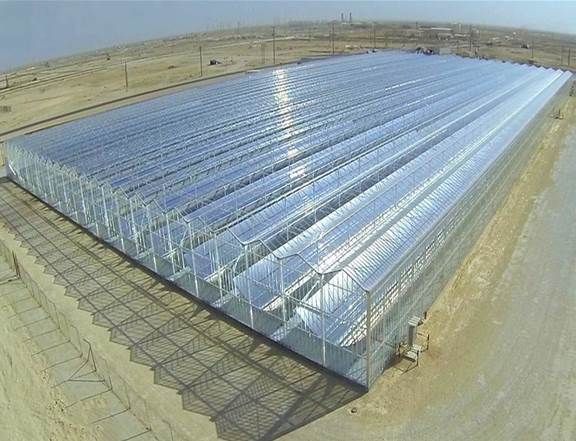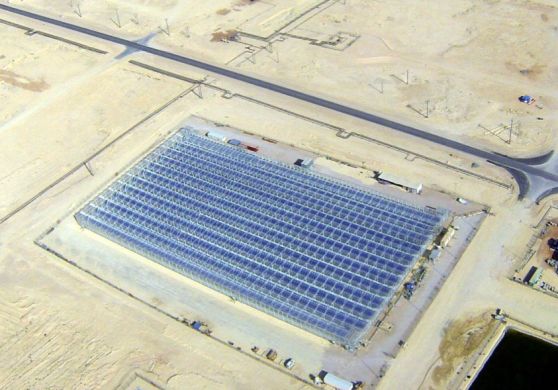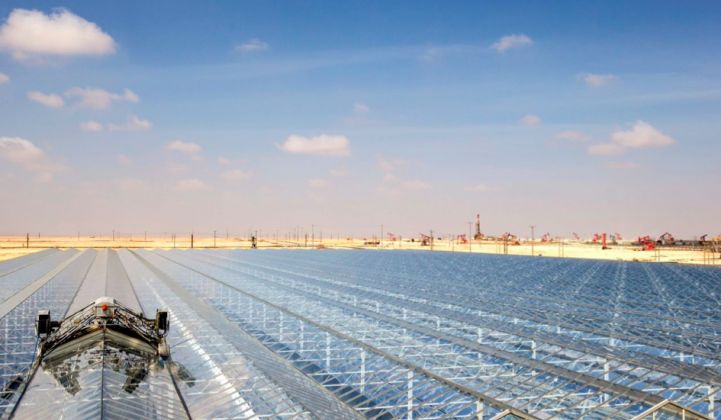Name a real-world, non-subsidized application in which concentrated solar power (CSP) could competitively replace natural gas in an enormous, emerging market.
It's solar enhanced oil recovery. Rod MacGregor, CEO of GlassPoint Solar, called it "a $115 billion heavy oil business opportunity."
And if GlassPoint's "gigawatt" project pipeline is any indication, the power of CSP might find its real niche in pulling difficult-to-access barrels of oil from the ground, rather than spinning a turbine to produce electricity.
GlassPoint just received a $53 million round C equity investment led by Oman's largest sovereign wealth fund, the State General Reserve Fund, along with the venture arm of Royal Dutch Shell and its original syndicate of venture firms: RockPort Capital, Nth Power and Chrysalix Energy Venture Capital. That brings GlassPoint's equity funding to more than $80 million since the startup's founding.
Much of the U.S.' conventional crude oil reserves remain in the ground because of the physics of oil flow. Enhanced oil recovery could liberate hundreds of billions of barrels of heavy oil, according to the EIA.
Oil field operators already use enormous amounts of natural gas to coax difficult-to-access heavy oil from depleted wells via thermal enhanced oil recovery (EOR). Thermal EOR involves injecting steam into a depleted oil field to thin the remaining heavier oil and move it toward the well. This technique has been used for decades and accounts for more than 40 percent of U.S. EOR production, mostly in California, according to the DOE. Gas EOR using natural gas, nitrogen, or carbon dioxide injection accounts for nearly 60 percent of EOR production in the U.S. The potential for exhaust carbon dioxide to be used for gas EOR is being heavily researched.
Oman uses 23 percent of its own expensive natural gas in its oil fields, primarily for thermal EOR, according to GlassPoint's CEO -- and those numbers are expected to grow as EOR projects contribute an increasing portion to U.S. and Mideast crude oil production.
"Up to 14 percent of all the gas burned in California is burned in Kern County, while Kuwait will burn more gas for EOR than for electricity," said the CEO on Friday. That gas might be better used for power generation, desalination, petroleum products or export. The Economist claims that the amount of gas used in gas-fired thermal EOR means that "a barrel of Californian heavy oil gives the stuff from Canada's tar sands a run for its money in terms of associated greenhouse-gas emissions."
GlassPoint’s greenhouse-enclosed parabolic solar troughs use mirrors to focus sunlight on a tube containing water, yielding high-pressure steam, which is injected into an oil reservoir to heat heavy oil. The greenhouse shields the mirrors from the desert elements, and an automated washing system cleans the glass.
The CEO noted, "The technology is radically different when we decided to go to oil and gas. The scale is so large, we had to take a step back with a clean sheet of paper." He explained that one of the cost drivers in a traditional CSP project is building the system to withstand wind -- strong foundations required more steel and concrete. GlassPoint's CSP system is enclosed in an agricultural greenhouse, which allows for cheaper, thinner mirrors and "half the amount of steel and aluminum" of an outdoor solar field, according to the CEO.
The system is direct water to steam, and in the case of GlassPoint, the water used is "produced water" from the well operations. This "horrible stuff," as the CEO referred to it, has to be used in the system with minimal cleanup.
GlassPoint installed a solar EOR project at an oil field operated by Berry Petroleum in Kern County, Calif. in 2011, which was used to preheat water for gas-fired steam generators. In May 2013, the Middle East's first solar EOR project was deployed, a 7-megawatt system developed with Petroleum Development Oman, Oman's largest oil company.
The real market, MacGregor said in an earlier interview, is the Middle East, where a “perfect EOR storm” favoring solar is setting in. Light crude in many Middle East fields is largely played out, he explained, and there is a shortage of natural gas, as well as plenty of sun.
The CEO spoke of a pipeline which included "multi-gigawatt" projects, saying, "It would not be unusual for a thermal EOR [system] to be in the 3-gigawatt range."
What about CSP for electricity?
The U.S. installed 517 megawatts of CSP in Q1 2014, more than the 410 megawatts installed in all of 2013, according to GTM Research.
Recently completed CSP projects include Abengoa’s 280-megawatt Solana parabolic trough project in Arizona with six hours of storage, NextEra’s 250-megawatt Genesis solar project, and BrightSource Energy's 370-megawatt Ivanpah solar power tower in California’s Mojave Desert. GTM Research says "the next notable project slated for completion is SolarReserve’s 110-megawatt Crescent Dunes plant, which entered the commissioning phase in February 2014." Crescent Dunes is a solar power tower outside Tonopah, Nevada, with ten hours of molten salt storage and a PPA from NV Energy.
As GTM Research reports, "Declines in PV module costs have undercut trough technology and put it at a significant cost disadvantage. Since the beginning of 2013, CSP projects totaling 1 gigawatt have been suspended, and an additional 305 megawatts have been delayed." Firms such as Areva, Siemens, Sopogy and Infinia have exited the CSP business. Abengoa, the Spanish-owned CSP developer, still maintains that declining capital costs and improved efficiency levels will make CSP competitive with combined-cycle gas turbines on cost, efficiency and utility by 2020.
Other CSP firms include eSolar, which has attempted a pivot to EOR, along with BrightSource. Unfortunately, the tower-based architecture employed by BrightSource and eSolar might be the wrong design for EOR.
Charles Haythornthwaite, partner at Chrysalix EVC, notes that his firm "was the original VC investor in GlassPoint." He added, "It might well be that CSP can ultimately compete with PV electric power if it can establish economies of scale. However, industrial heat is a huge market opportunity (hundreds of billions of dollars) in its own right -- and unlike electric power, it’s the CSP application that PV cannot touch. Instead, the real competition is natural gas, and in many parts of the world, gas is constrained or extremely expensive."
But is it green?
GlassPoint CEO MacGregor pointed out that oil companies are "heating a cubic mile of earth."
With gas.
The 1.7 quadrillion Btu of gas used to power thermal EOR, GlassPoint's CEO pointed out, "could power six of the largest states."
So, yes, this is about oil. But until humanity kicks the oil monkey off its back, solar EOR provides some harm reduction. Soon to blow the mind of a liberal near you: solar-powered tar sands extraction.
As the CEO notes, solar EOR can reduce an oil field’s natural gas consumption by up to 80 percent.
That's plenty green.
Pictures of the Mideast's first solar EOR project, a 7-megawatt system developed with PDO, Oman's largest oil company:








